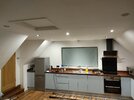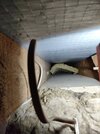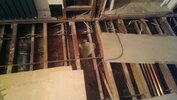Its always cold in winter and hot in summer. Apart from knocking it all down and starting again are there any quickish wins to be had here? I used my infrared thermometer and all it really told me was that the top of the room is warmer than the bottom.....
The rest of the house doesn't have spectacular insulation although does have loft insulation to about 270mm and cavity wall blow in (100mm cavity I think) but it is way, way warmer in Winter. The room above the garage is so bad its not really liveable in winter or summer (gets too hot).
But the odd thing is the quality of insulation in this room isn't _that_ much worse I think. It has:
loft above garage room: 100mm fibre glass insulation (easy to top that up but its only a small area - see pic)
rafter insulation - accounts for about half the wall area of the room. Currently has 75mm rockwool batts (see other pic - top batt removed for photo)
"dwarf" wall - cavity wall with cavity I think only 75mm stuffed with rockwool
floor - stuffed with you guessed it rockwool
I can access the rafters from the loft space above the room and I could also fairly easily access the rafters and the wall from outside by removing roof tiles. So could probably get kingspan type insulation between the rafters but thats only a half of the wall area and tiny part of the area all together
But am I looking in the wrong place? Given there is an unheated garage below is the floor the problem? Or should I concentrate more on the room as heat goes up?
The rest of the house doesn't have spectacular insulation although does have loft insulation to about 270mm and cavity wall blow in (100mm cavity I think) but it is way, way warmer in Winter. The room above the garage is so bad its not really liveable in winter or summer (gets too hot).
But the odd thing is the quality of insulation in this room isn't _that_ much worse I think. It has:
loft above garage room: 100mm fibre glass insulation (easy to top that up but its only a small area - see pic)
rafter insulation - accounts for about half the wall area of the room. Currently has 75mm rockwool batts (see other pic - top batt removed for photo)
"dwarf" wall - cavity wall with cavity I think only 75mm stuffed with rockwool
floor - stuffed with you guessed it rockwool
I can access the rafters from the loft space above the room and I could also fairly easily access the rafters and the wall from outside by removing roof tiles. So could probably get kingspan type insulation between the rafters but thats only a half of the wall area and tiny part of the area all together
But am I looking in the wrong place? Given there is an unheated garage below is the floor the problem? Or should I concentrate more on the room as heat goes up?






